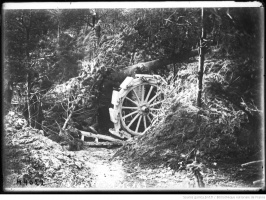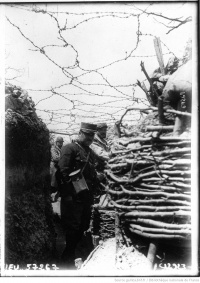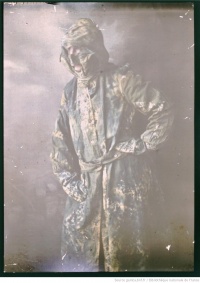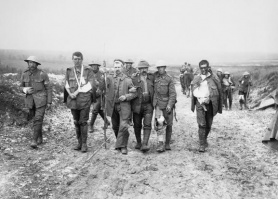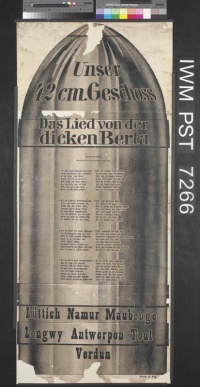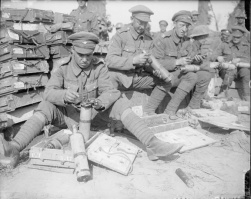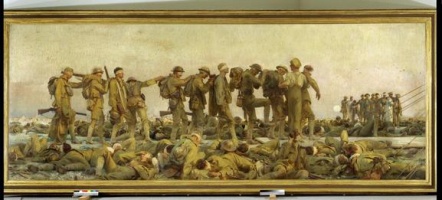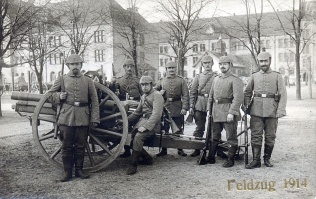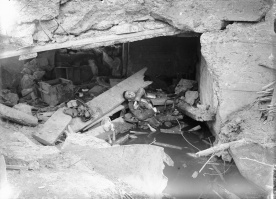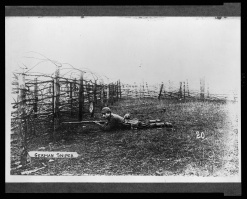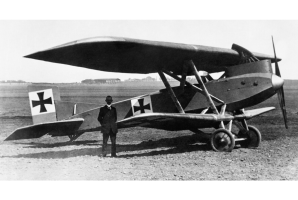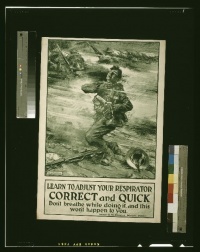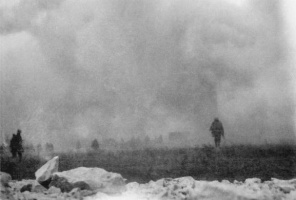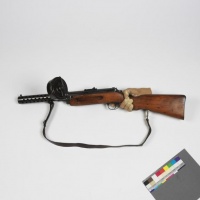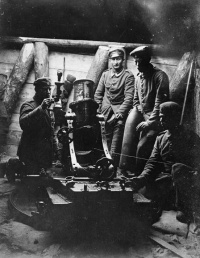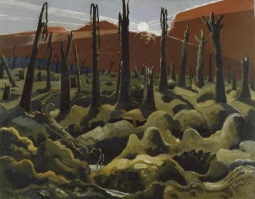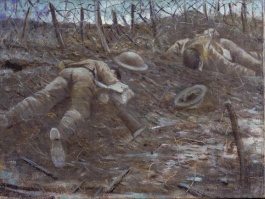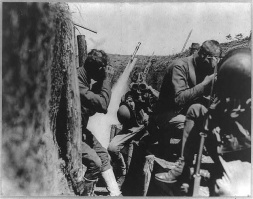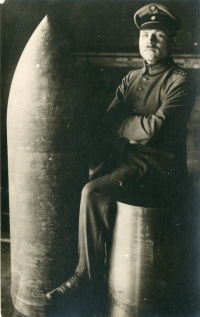Introduction↑
It would be absurd to study war without studying combat – and to study combat without studying weapons. Yet many scholars of war – including scholars of the First World War – have skirted the issue of weaponry. Quite a few reasons explain this avoidance. The field of weapons expertise has long been left to specialists lacking scholarly legitimacy, whether collectors or adherents of the most traditional kind of military history. As a result, knowing a great deal about weapons, at least modern ones, does not net one a great deal of academic credibility – rather the opposite.
Yet this blind spot leads Great War scholarship into an impasse. For weapons are inseparable from bodies, and from the injuries inflicted on bodies – and what are combat and war all about, if not the human body? Overlooking weapons means overlooking the violation of anatomic barriers, it means overlooking injury and death, and, more in general, it means overlooking suffering. It is no coincidence that neglect of the issue of weapons has gone hand in hand with neglect of the issue of war medicine (which has been passed over for a long time, with the exception of war psychiatry).
Weapons are tightly linked to the body-at-war in yet another, less immediately obvious way. Individual weapons – the kind that the soldiers of the Great War lived with day and night – do not just extend the body. They also inflect the way it moves, even if we do not know enough about soldiers’ range and modes of motion during combat in 1914-1918. Weapons also open up a range of sensory experiences: one grips them, one feels their weight, one handles them. Nor is the range of experiences sensory only: the bonds between soldiers and their weapons are affective ones, too.[1] Even in modern warfare, soldiers make their individual weapon theirs. Even if the soldiers of the Great War were in all probability less attached to their hand weapon than Napoleon I, Emperor of the French’s (1769-1821) soldiers to theirs a century earlier, they were still on intimate terms with the tool that was destined to take their adversaries’ lives and protect their own. And as to crew-served weapons – cannon, machine guns – they, too, carried great affective significance. In short, through weapons, one grasps soldiers and their world. In warfare, arms are far more than just the tools of combat.
The study of weapons is all the more central to the study of the First World War because of their evolution during the conflict – which is partly a contradictory evolution. On the one hand, soldiers were armed with ever more modernized weapons, as the major belligerent powers implemented the technological prowess that had not been fully utilized before the war. There is a technological abyss between the European armies’ weaponry in the summer of 1914 and that of the autumn of 1918. While it is true that there was only one completely new weapon – poison gas – the means of combat changed utterly in the mere four-and-a-half years between war’s outbreak and its end. The ever-increasing sophistication of weaponry required an ever-increasing specialization of soldiers and of base command; as a result, by war’s end, the combatants of the modern mass armies had become specialized technicians as well as soldiers. Combat organization changed accordingly, as did command.[2] The evolution of arms, then, made for quite a few other changes.
Yet the changes in weaponry between 1914 and 1918 did not all point in the direction of modernization. There were remarkable regressive dynamics at work as well. Because the war was, in essence, siege warfare in the open field, it revived older siege techniques which had been abandoned for a long time but now proved their technical relevance – in a new context and with new technologies and materials. One may call this process “retro-innovation,” and it involves a wide range of implements – helmets, trench artillery, grenades, sentries’ armor, tank crews’ chain-mail masks, and so on. All of these are tools to both attack and to protect the body that hailed from earlier ages of war and were incorporated anew into modern warfare.
All this to say that the question of weapons in 1914-1918 opens up a trove of insights. The brief sketch attempted below mainly means to state how essential it is that fresh pains be taken to reexamine the question.
The Cannon: Lord of the Great War↑
Heavy guns were the war’s most important weapons. They owed this dominance to several major inventions of the last third of the 19th century: rifled steel tubes, increased calibres, hydraulic brakes, and, thanks to new types of gunpowder, the development of much more powerful ammunition.
At the start of the war, the different belligerents’ artillery consisted mainly of field guns defined as “rapid-fire” because their hydraulic brakes dispensed crews from having to set them back to firing position after each shot; they were designed to support moving troops.[3] At high speed and low range, they fired shells at visible targets. The French “75”, the best gun of its time, was grouped in small batteries to offer close support to the advancing infantry. The German 77-mm Krupp gun (which was also used by the Austro-Hungarian army), the 18-pounder British gun, the 3-inch Russian and U.S. field guns, were all comparable arms.
Yet the war’s first weeks mainly highlighted the central role of the heavy guns – as epitomized in the German 420-mm and the Austrian 305-mm guns’ pulverizing of the forts of Liège and Namur in August 1914.[4] The start of the stalemate further confirmed the crucial role of heavy artillery to reach deeply ensconced dugouts, to destroy trenches and to hit the enemy’s rear positions. Trench warfare stimulated the development of new models of heavy guns that were better able to reach dugouts than was the case for direct-fire guns. The new howitzers fired off shells at short distance and at a high angle at dug-in targets. Static warfare made for ever-heavier guns – 200 to 400mm. Having said this, next to heavy artillery, mobile high-angle artillery – developed for short-distance bombing - grew as well. The innovation of German Minenwerfer was, at first, on the French side, responded to by obsolete arms and more or less improvised equipment; eventually, by late 1915, actual mortars (known as crapouillots) entered the field. On the British side, the Stokes Mortars came into action in 1916.
Massive bombing became the main tactical answer to the stalemate. Various forms of firing pursued various tactical objectives: reprisal fire, demonstration fire, trial fire, concentration fire, destruction or annihilation fire, adjustment fire, barrage or box barrage fire, harassing fire, and so on – not to mention the firing of shrapnel which exploded high up with devastating consequences, and the firing of toxic grenades which became ever more important as the conflict wore on. All in all, the new role of artillery made for a massive increase in guns and in shots. During the week-long allied bombing that preceded the Somme attack of 1 July 1916, 1.5 million shells were fired by British gunners (who expended enormous physical effort in doing so), which translates into an average of thirty shots for every square kilometre. In 1918, the allied offensives on the Western and Italian fronts were sustained by, on average, 5,000 to 8,000 artillery pieces; in this manner, the French army alone expended 2,200,000 shells between 10 March and 20 March 1918. This spectacular development had many consequences. Aerial observation became ever more necessary – which in turn necessitated the camouflaging of positions. Traction had to become increasingly mechanized. On a more systemic level, the spectacular predominance of heavy guns required further industrialization of warfare and the ever-intensified economic and social mobilization of the belligerent societies.
Shells did not just aim at soldiers’ bodies as they burrowed into the soil as best they could. They also targeted an enemy positioned in front of soldiers’ line of defense: viz., barbed wire – that passive weapon that proved its frightful efficiency during the Great War. Barbed wire was invented in the U.S. at the end of the 1860s to contain cattle. As industry was soon able to produce an improved version cheaply, barbed wire became a staple of western warfare in the early 20th century. From late 1914 and early 1915, the Great War marked barbed wire’s definitive adoption as a decisive instrument of static warfare. It was unfurled on no man’s land, as well as placed between the different lines of deep defense. Barbed wire influenced the combat practices of the Great War profoundly. Its use explains the superiority of the defensive over the offensive on the Western Front until the final upsets of the summer of 1918.
All the more so as barbed wire kept becoming more elaborate. Its use went from fairly minimal setups – wires strung along pickets fixed in the ground – to varied and complex systems meant to sustain and reinforce each other: large rolls of wire unfurled in the manner of long coils; portable steel chevaux de frise; wire spread on the ground to halt passage by crawling, and alert-sound systems attached to the wires to prevent night-time surprises. In sectors where the opposing lines stood close to each other, the wires were even electrified to render them more impenetrable. In this manner, barbed wire, which was thinly spread at first, eventually made for formidable defense networks. They were constantly reinforced, at the price of enormous efforts, made at night, by harassed second-line troops.
Any attack proved the barbed-wire networks’ frightful defensive effectiveness. The infantry troops were given pincers to cut through the wire to during the preparations for attacks, but these were able only to make small breaches. It was up to artillery to destroy enemy wire. But it too was often unable to create a large enough opening. Attackers faced a dilemma: the massive, drawn-out bombing required to cut through enemy wire precluded surprise attacks, while if the bombing were cut short, the wire would still largely stand and hold up infantry attacks – and the men would be helpless targets for the defenders’ machine guns trained on the too-rare and too-narrow holes made by the attackers’ cannon.
As a result, once men left the forward trenches and found that the wire had not been dislocated by the preparatory bombing, they knew that courage and determination would be of no avail. The efficacy of those iron ramparts was not lost on troops used to the awful sight of corpses that were stuck for days, weeks or even months on the steel spikes strung out between the lines – the “drying-rack,” as the French troops cynically called it – and that no-one was able to detach to give them a decent burial. It is no coincidence that one of the very few British paintings that shows the corpses, not of the enemy, but on the own side, viz., Christopher R.W. Nevinson’s (1889-1946) 1917 painting "Paths of Glory", shows two dead men in front of an intact-looking, impassable wall of wire.
From 1916, the great battles of matériel dominated by the heavy guns created a lunar landscape: “All day (and at night too, when the light of the fuses allows) one’s eyes meet a spectacle of desolation and horror,” wrote, in October 1916, the trench paper of one company of the 144th French infantry regiment.
This is the spectacle of destruction painted by Paul Nash (1889-1946) in his ironically-titled “We Are Making A New World.”[6]
The emergence of such a landscape, wholly created by cannon, also shows that artillery in a way created its own limitations: it was impossible to transport heavy guns across shell-pocked terrain. This made it impossible for artillery to offer support to far-flung infantry attacks. Paradoxically, then, the very violence of bombing in 1914-1918 intrinsically obstructed major attempts at breakthrough. Moreover, even the most powerful artillery never managed to destroy deep dugouts; this was the case on the Somme in 1916 or at the Chemin des Dames in 1917, where the deeply ensconced German positions held out against preparatory pounding by enemy artillery.
For all that, 70 percent to 80 percent of all of the wounds inflicted during the Great War were due to shells. Even though many shells did not explode in the mud of no man’s land, those that did projected an extremely lethal mass of shards. Shrapnel victims were often wounded all over their bodies by dozens or more of fragments. Propelled at extreme speed, the largest splinters could tear apart any part of the human body. A direct hit would literally dissolve a man’s body. The trauma of experiencing a bombing is described in a 1930 text as follows:
And yet in spite of the terror, or more precisely because of it, one must note that the cannon fascinated too. As an obvious metaphor for the erect penis, it often served the purpose of exalting combatant virility. Men were facinated by the power of the guns; one example is a description of a shelling of the enemy in a chasseurs alpins front-line paper:
In October 1914, the German painter and writer Max Beckmann (1884-1950) was struck by that same transcendental dimension: “When a blast makes itself heard close by, it is as if the gates of Eternity open up. It all suggests space, far horizons, infinity. I would love to, I could paint that roar. Oh, that immensely beautiful abyss makes one shiver!”[9] One is reminded of how futurist painters and poets such as Filippo Marinetti (1876-1944) held bombings in awe. One is also reminded of the painter Fernand Léger’s (1881-1955) reverence for the troubling perfection of the instrument of death that was the field-gun: “The sight of a 75er’s open breech in the sunlight dazzled me... It taught me more about plasticity than all the museums in the world.”[10]
The Terror of the Machine Gun↑
In his memoir Strange Defeat, the French historian Marc Bloch (1886-1944) wrote, referring to his combat experience during the Great War, that “only the blast of the machine gun spares literally no-one.”[11] Indeed combatants’ memories of the machine gun were terrible. It was a relatively new war weapon in 1914. The Russo-Japanese war of 1904-1905 and the Balkan wars 1912-1913 had first opened up the possibilities of its military use, but they had been deployed in numbers too small to make a difference. But during the Great War, once some commanders’ failure to acknowledge its crucial role was vanquished, the machine gun became, together with the cannon, the determining weapon of the battlefield.
Very much a weapon born of industrial warfare, the machine gun owed its frightful effectiveness to its firing speed: 400 to 600 shots a minute on average. During the war, ever more sophisticated models accommodated ammunition-belts that allowed them to keep up this high speed over longer periods. Those machine guns not silenced by heavy shelling were able to throw up a rampart of projectiles that made it impossible for assailants to cross no man’s land. Their defensive efficacy was even more formidable when they were placed in a position to target expected lines of attack – as happened on the Somme on 1 July 1916. Attacking troops who heard the typical sounds of the machine guns knew that they were marching towards death. This may be why enemy machine guns were among the rare weapons not destroyed but carried back as trophies by those attackers who had been able to break through.
Yet machine guns had their weaknesses, and this holds for a range of different models deployed from 1914 to 1918. All of them tended to overheat and to require complicated systems of cooling by air or by water so as to avoid warping and jamming. Even so they often malfunctioned. Machine guns were complicated pieces of machinery and required specialist crews. Moreover, they were unwieldy, the heaviest of them weighing forty to sixty kilos – not counting the carriages, ammunition, and some models’ armored shields. It took three to six men to operate them. They were, therefore, mainly deployed in a defensive capacity and set in camouflaged shelters. Machine guns could only become offensive weapons – or, to be correct, become offensive weapons again – when they were mounted on airplanes or tanks.
Wartime weapons engineering therefore concentrated on rendering machine guns more manageable. In 1915, the Germans fielded a lighter model, the Bergmann. In that same year, the French improved the Chauchat. Now weighing under ten kilos, it became the infantry’s main close-cover support weapon. The twelve-kilo U.S. Lewis gun became the machine gun of choice in the British and Belgian armies. And yet none of these were convenient enough to be able to usefully escort assault troops. Only at war’s end did different belligerents develop even lighter models that could be carried by one man: the first French machine gun rifles, and the German Bergmann Maschinenpistole, in use during the battles of the autumn of 1918 (they were put to reverse use actually – as defensive weapons during the retreating battles of the war’s last weeks).
The Soldiers’ Arms↑
At the start of the war, the infantryman’s arms equipment (with the exception of officers’ revolvers and sabres) was fairly standardized. The main item was the rifle. Intensely developed since the 1890s, the rifles in use in the main European armies were small-calibre, bolt-action, magazine-fed repeating rifles – the German Mauser (1898), the British Lee-Enfield (1907), and the French Lebel (1887) being the main examples.
These were all in use in 1914. They had a useable scope of 600 metres and a maximum range of about 1,400. Their conical and pivoting bullets inflicted wounds of a hitherto unseen severity, because the blast destroyed bone and muscle well beyond the entry-wound. While the possession of a rifle may have been reassuring to the combatants, they were of limited use in the specific circumstances of the Great War’s clashes. No collective rifle-fire could rival that of machine guns, which, although their range was shorter, possessed a firepower equivalent to that of a hundred men firing individually. Moreover, soldiers were rarely sure that they had really hit an adversary.
Rifles also featured bayonets, hailed as the ultimate offensive weapon at the start of the war for its putative psychological effects on the adversary’s morale. Later on, during stalemated combat, bayonets became close-combat weapons of choice – at least in theory. In reality, rifles were unwieldy weapons because of their size and all the more so with bayonets affixed; they were encumbrances both in attack and in defense and especially in close combat. Unsurprisingly, other weapons came to complement the initial equipment.
Different models of hand grenades, for instance, became ever more important in soldiers’ arms kits. Grenades had originally been siege weapons. The first modern hand grenades were used during the Russo-Japanese war and had made enough of a mark to interest the German General Staff – which as a result possessed a large supply of grenades as the war broke out. The French and Russian armies, by contrast, had few grenades; the British forces, until the spring of 1915, had none at all. Still, hand grenades developed rapidly on the Western Front. Since they were not easy to operate – one had to observe a delay before throwing them so as to avoid it being thrown back before detonation – they were wielded by specialized grenadiers. These were sent out in front of the main attacking body, and became a major force in infantry offensives in 1918, as evidenced by Ernst Jünger’s (1895-1998) memoir Storm of Steel (the 1920 version), which stresses the massive use of hand grenades by assault troops at war’s end – the German stick grenade (Stielhandgranate) being a particularly redoubtable weapon. For all that hand grenades were attack weapons, they were also used intensely as close-defense arms, as night-patrol arms in no man’s land, or as “cleansing” arms in enemy trenches. In addition, grenades could be linked to the more traditional weapon that was the rifle in so far as they could be projected with rifle-mounted launchers, which increased their scope.
The demands of close combat also made for the development of hand-to-hand-combat weapons – though it is hard to know on what scale and in what manner they were used. At any rate war museums today possess a wide range of trench bludgeons in a very wide variety of models; they seem to have been meant to help capture prisoners in no man’s land, or, perhaps, for close-range defense in case of enemy assault on one’s positions. They seem to have been especially prevalent with the British army. In the German army, by contrast, the sharp-edge trench spade was officially designated the hand-to-hand combat weapon of choice after 1916.
There were, it seems, a great many knives too, on all fronts. One notes how intensely they circulated in the French army all through the war. They could be army-issue knives, daggers and hunting knives from before the war, hand-made weapons from regimental workshops or even products of individual soldiers’ handicraft. At any rate, mass production started in the spring of 1915; by the end of August 1916, supplies were considered satisfactory at some 650,000 to 800,000 knives, which meant one out of every three French soldiers may have been equipped with one. Knives, in short, were massively present at the front.
This quantitative weight of cutting weapons has long been underestimated. The industrial aspect of the Great War – modern, anonymous, and hence exculpatory for those engaged in it – has obscured its other aspects. It is true that we know next to nothing about the actual use of these weapons. But the fact that so many soldiers carried these hand-to-hand-combat arms about them indicates that they expected, and feared, this kind of combat.
New Arms: Airplanes, Tanks, Poison gas↑
Air forces, fledgling at the start of the war, developed rapidly in the course of it, especially on the Western front which was the most important theatre of operations in this domain as in others. At war’s end, the major belligerents possessed several thousands of planes.
But the most spectacular changes were qualitative not quantitative. In 1914, the engines were too weak to transport weighty charges, fly against the wind, or fly at night. Aviation served reconnaissance (for instance, in the preparation for the battle of the Marne), it liaised, and it guided artillery. Only on occasion did planes throw light bombs or grenades, or anti-personnel flechettes. But the start of the war of positions increased the role of aviation: long-distance reconnaissance missions became more important, as did close aerial photography and artillery locating – at great cost (most of the downed planes in 1914-1918 were reconnaissance planes). This in turn called forth anti-aircraft weaponry, as well as fighter-plane forces meant to close off the skies to the adversary.
During the two first years of the war, air duels between “aces” fascinated public opinion everywhere – proof of the way in which the old warrior ethic that had disappeared in the mud of the trenches managed, paradoxically, to find shelter in the war’s most modern weapon. Subsequently, from 1916, aviation changed in a major way: airplanes gained in speed, in agility, in the ability to ascend fast, in ease of flight – and they became more robust. Different types of planes emerged to serve different functions: fighter planes, bombers, reconnaissance craft, and planes designed to assist the infantry directly. Squadrons grew in size. Major technological innovations appeared: machine guns synchronized with the helix; gun sights for bombing; cameras; radios; incendiary and anti-armor bullets; heavier and more effective bombs. Technological competition between the adversaries was fierce; the edge lay now with one camp, now with the other. Yet at the end of the war, the Germans’ industrial difficulties, together with the dearth of fuel and the lack of pilots, progressively paralyzed the Central Powers’ aviation. By the autumn of 1918, allied domination of the air was absolute.
By then, planes were deployed en masse. Groups of several dozens engaged in dogfights; planes performed strategic bombing operations; or they offered large-scale support to land offensives. From March through November 1918, attacking enemy trenches became aviation’s main tactical task; which is to say aviation played a crucial role in all of the battles of the war’s last year. This happened at the price of enormous losses, especially because of anti-aircraft defense, protective netting, projectors, barrage balloons, incendiary ammunition, and defensive fighter-plane action.
From 1917, airplanes’ action was ever more tightly linked to that of tanks. Tanks were a direct response to the strategic blockade of the Western Front. The British Navy formulated the first requirements from early 1915, then put together the prototypes and launched the building of experimental models. From April 1916, the first Mark I engines were produced, under the code name “water tanks” – the name “tank” would stick. All of the British heavy tanks (from Mark II to 1918’s Mark V) were modified versions of that first model.
French research into these “assault charriots” was stimulated by British progress. The French military engineer Colonel Jean-Baptiste Estienne (1860-1936) started experiments in late 1915; their results were put into practice in early 1916, with the vehicles commissioned from the Schneider factories at Le Creusot and the factories at Saint-Chamond (Loire). These tanks were equipped with 75-mm field guns and meant as mobile artillery – hence their name, “assault artillery.” They were first deployed during the April 1917 Nivelle offensive.
Because they had been developed by the Navy (where they were called “Landships”), the British heavy tanks were described in naval terms – their teams were known as “crews” (eighteen men inside the Mark I), the tanks featured “turrets” and “hulls” and the first Mark models even had a rudder in the back. Their losenge form, designed to help them cross obstacles in the manner of a ship crossing a wave, further deepend this kinship with armored vessels.
But on the battlefield they disappointed. On 15 September 1916, on the Somme, 60 Mark I tanks were deployed, with enormous losses and no result whatever. At the battle of Arras in April 1917, new models appeared, again without convincing results. The Mark IV tanks deployed at Messines in June 1917 and at Ypres in the following summer were incapacitated by mud. The French heavy tanks were no more successful. In April 1917, operating on overly churned-up terrain, they suffered a loss rate of 60 percent (they burned out, were destroyed by enemy artillery, or broke down). Only in October 1917 did they enjoy their first real successes, at the French offensive of Malmaison, where they managed to open up the route to the attacking infantry troops and to silence the machine guns. Likewise, the British Tank Corps’ attack on Cambrai on 20 November 1917, which fielded close to 380 heavy tanks, was able to crush the first two lines of defense – before being badly mauled by German artillery.
That is precisely why the Germans took a very long time taking tanks seriously. After the final routing of the British tanks at Cambrai in November 1917, Ludendorff let it be known that “the best arms against tanks are solid nerves, discipline and pluck.” It is true that the German forces developed an array of efficient anti-tank measures: support points for one or two field guns; ditches; large camouflaged craters; mine-fields consisting of interred mortars; short-range barrages by heavy guns and my machine guns; anti-tank rifles.
Inside the tanks, the combat experience was exceptionally harsh: claustrophobia, lack of vision, appalling heat, noise, the engine’s rolling and bobbing, the unbearable bumps. One could be burned alive; a direct hit could disintegrate one. Whenever the tank hit an obstacle, the men violently bumped against the hull, or were hit by objects flying around, or both. The short-range barrages by the machine guns could penetrate the vision slits – which accounts for the large number of facial injuries among tank crews.
The British army conducted research into a lighter type of tank; the medium-size Whippet was introduced in late 1917 and became ever more important through 1918. Yet it did not abandon the heavier tanks, which, with the help of a thousand French planes, assisted the attack in Picardy on 8 August 1918. As to the French army, it opted more fully for the lighter type of tanks; production was entrusted to Renault in October 1917. Almost 500 of these emerged from the forest of Villers-Cotterêts during the Aisne counteroffensive of 16 July 1918, and, sustained by hundreds of airplanes, made all the difference. They were also deployed in that year’s final offensives, most notably in the joint French-American Meuse-Argonne offensive of 26 September.
From an anthropological point of view, if heavy tanks seem to be the terrestrial offshoot of warships, then light tanks are the automated answer to horses. From the start of the war it had become obvious that the cavalry had lost its age-old role as breakthrough weapon on the battlefield. (The Franco-Prussian war, it is true, had been a harbinger of this development already.) The Renault tank weighed 6.5 tons, advanced at a speed of nine kilometres an hour, necessitated only a two-man crew, and was equipped only with a machine gun and a 37-mm cannon. Light tanks like these offered as it were a second life to cavalrymen, and there were many of them among the tank crews. In a Renault tank, the commander made his orders known to the pilot by body language; and much of the vocabulary used, as reported by eyewitnesses, shows this kinship with the “horseman’s experience.” One notes, also, the tank crews’ emotional attachment to their machine, often described as a living being possessing a “heart,” a “back,” “flanks,” and a “belly.” They were given proper names – often, women’s names. Tank crews referred to their machines’ “wounds.” This “horse experience” found its way to aviation as well; cavalry officers were as numerous there as they were in tank crews. Fighter planes were considered to be just like race-horses: they were, like them, unstable and agile; it was important in both to have a “good seat” and to steer with confidence; and horse-riding terms abounded in aviation - planes were known to “rear up.” Finally, air combat, at least at the start, was directly derived from cavalry traditions. All in all, whether “landships” or mechanized horses, tanks and airplanes, now closely linked, prefigured a fundamental shift in the means of combat in the 20th century.
With the first major gas attack at Ypres in April 1915, poison gas emerged on the scene, quite spectacularly, as a new weapon. Eventually, gas was adopted by the adversaries (the British used it from 13 October 1915; the French only from February 1916) and became the object of constant competitive innovation. Gas was first diffused by canisters, but eventually projected in shells, which freed attackers from having to await favorable winds; by the last months of the fighting in 1918, one-fifth of all shells fired were poison-gas shells.[12] The “race to toxicity”[13] also led armies to replace chlorine with phosgene in gas shells; the first were fired at Verdun in February 1916. It also led to the development of disphosgene in Germany (which was more convenient to handle because it was a liquid). The next step was yperite, or “mustard gas,” a blister agent which restored poison gas warfare’s effectiveness against stepped-up protection measures. Yperite was slightly smelly but colorless, hence invisible; it was not very volatile, and therefore very persistent; it contaminated places, objects and clothes for a long time; it attacked all of the body’s mucous membranes even through the fabric of the uniforms, eating away at tissue and killing cells; it burned men’s eyes and made them blind. One magnificent and terrible painting by John Singer Sargent (1856-1925), Gassed, shows the effects of this new poison. It depicts long lines of blinded soldiers with bandaged eyes, leaving the battlefield in 1918 in single file in groups of twelve led by a medical orderly, each of them grasping the shoulder of the man before him.[14] The awfulness of the new weapon is also depicted in Eric Kennington’s (1888-1960) portrayals of soldiers with twisted faces and burned eyes, contorted by suffering.[15]
Because of this new type of poison gas, the number of allied gas casualties rose during the war’s last year – up to 15 percent of all of the dead, wounded and missing. When calculated over the entire war, yperite made eight times as many victims as all of the other poison gases developed in Germany. The French and British did not follow suit until June and September 1918, respectively. Overall, the mortality rate was not particularly high: 2.4 percent of the men touched by yperite died. It wounded more than it killed. But it wounded badly: even the most lightly touched men were out of commission for two or three months.
For all that poison gases were being constantly updated, they never effected a breakthrough of the enemy’s front. Chemical warfare wound up being just another component of attrition warfare; it slotted into the overall strategic situation of the superiority of the defensive over the offensive, which lasted until the summer of 1918.
Yet chemical warfare has left a memory of exceptional awfulness, which has not abated between 1915 and the present day. Those who were exposed to it felt as if they were entering a kind of war of unprecedented atrociousness. One trench journal, written by soldiers of the French 83rd Infantry Regiment on 20 March 1917 after being hit by a drifting cloud, expresses it well:
Poison gas, then, gave men the impression that something was being inflicted beyond all that had come before, opening up a radically new area of suffering and violence. And yet, within the highly murderous context of the Great War, gas made relatively few – if one may say so – victims. Estimates are at 496,000 dead and wounded (the wounded being the vast majority), a sizeable number at first sight, but amounting to “only” 3 percent of total losses on the Western Front. If one takes all of the fronts over the entirety of the war’s duration, the estimates remain the same – between 2.3 percent and 3.2 percent of total losses (dead, wounded, missing). Moreover, most men hit by gas survived. The mortality rate was between 1.9 percent and 3 percent, as against 30 percent to 39 percent for the other types of injuries. The number of gas dead on the Western Front is estimated at 17,000, half of them in the last year of the war because of the particularly lethal effects of yperite. In other words, 0.5 percent of all of the dead on the Western Front.
Then why were poison gases remembered with such particular horror? The historian of gas warfare Olivier Lepick has pointed to the devastating psychological effects of gas attacks on soldiers, to their feelings of isolation underneath their masks. Moreover, gas attacks generated intolerable uncertainty: soldiers were able to recognize “traditional” shells by their sound and make educated guesses as to where they would land, but it was far harder to gauge where a gas attack would hit and how lethal the gas would be. Poison gases were silent, and, in the case of yperite, invisible. And their delayed impact – after a gas attack one could never be quite sure one was unharmed – added to the terror. Moreover, there was the particular awfulness of dying by gas. One British army physician, more than twenty-five years after the war, described the horror of seeing men choke to death, unable to catch their breath. Men wounded by bullets or shrapnel, he wrote, also died of wounds, but they surely did not feel that the life was being dragged out of their bodies.[17]
One might add that poison gases made lethal wounds without puncturing the anatomical barrier, in other words without drawing blood. Yet from an anthropological point of view, warfare makes sense only if, as in hunting, there is aperture and outflow.[18] The writer André Malraux (1901-1976) suggests as much in his description of his own father’s sight of a group of gas victims:
What inspires terror here is the absence of any visible wound, the absence of blood, pointing to a transgression that may well be fundamental: that of death being inflicted without the enemy’s body having been opened up and his blood being drawn. The fact that poison gas killed without the slightest puncture of the skin, of that fragile cover of the human body, may well explain much of the terror that it inspired and continues to inspire.
Conclusion↑
The victory celebrations of the summer of 1919 in London and Paris featured impressive arms trophies, displayed in the streets for the benefit of the immense crowds that had gathered. Those weapons taken from the vanquished enemy, now neutralized and piled up in vast shapeless heaps, expressed victory itself, they rendered it tangible and visible. One would have thought that such trophies would be bizarre and outdated after an industrial war in which weapons had been so massively produced and so easily replaced. Yet these heaps of metal made victory sacred in the manner of the trophies offered up to the gods by victorious warriors in antiquity – with significant differences to be sure, and yet harking back to the traditional way of expressing that one had vanquished one’s enemy. Those trophies displayed in jubilant cities in 1919 demonstrate that the tools of death of the Great War cannot be seen solely as factory products approvisioning industrial war. Some of the long-standing symbolic significance of weapons and of their handling seems to have emerged intact from those long years of carnage.
Stéphane Audoin-Rouzeau, Ecole des Hautes Etudes en Sciences Sociales
Section Editors: Michael Neiberg; Sophie De Schaepdrijver
Translator: Sophie De Schaepdrijver
Notes
- ↑ The anthropologist Jean-Pierre Warnier uses the instructive term “‘sensori-affectivo-motor’ conducts” to indicate what is at stake in all bodily techniques. See, for instance, his chapter “Inside and Outside. Surfaces and Containers,” in Tilley, Christopher et al. (eds.): Handbook of Material Culture, London et al. 2006, pp. 186-195.
- ↑ On the latter, see Saint-Fuscien, Emmanuel: A vos ordres? La relation d’autorité dans l’armée française de la Grande Guerre, Paris 2011, p. 310.
- ↑ In 1914, the German army fielded 4,300 77-mm guns; the French army, 3,900 75-mm guns.
- ↑ The German army possessed 2,000 heavy pieces in 1914.
- ↑ "Une relève dans un secteur agité", in L’Echo des Guitounes, 30 October 1916, n. 26, p. 1, http://gallica.bnf.fr/ark:/12148/bpt6k5679711c (retrieved: 16 September 2014).
- ↑ Nash, Paul: "We are Making A New World", Imperial War Museum.
- ↑ Chevallier, Gabriel: La peur, Paris 1930, p. 54.
- ↑ "Avant l’attaque", in Le Diable au Cor, 15 August 1916, n. 29, p. 1, http://collections.bm-lyon.fr/BML_02PER0010117271?page=1&query[]=id_title_s:%22BML_02PER0010127869_Le%20Diable%20au%20cor%22&hitStart=126&hitTotal=222&hitPageSize=12 (retrieved: 16 September 2014).
- ↑ Cited by Becker, Annette: "Les artistes", in Audoin-Rouzeau, Stéphane and Becker, Jean-Jacques (eds.): Encyclopédie de la Grande Guerre, 1914-1918, Paris, p. 691.
- ↑ Ibid.
- ↑ Bloch, Marc: L’étrange défaite, Paris 1990, p. 56.
- ↑ In a parallel development, the British Livens Projector, from the summer of 1916, and before long its German counterpart, functioned as poison-gas bomb throwers and were able to swiftly create a very large toxic cloud inside the ranks of the enemy, who was deprived of the possibility of sounding the alert.
- ↑ Lepick, Olivier: La Grande Guerre chimique, 1914-1918, Paris 1998, p. 207.
- ↑ Singer Sargent, John: Gassed, Imperial War Museum.
- ↑ Kenington, Eric: Gassed and Wounded, Imperial War Museum.
- ↑ "Les Gaz. A ceux qui les ont vus", in: Le Filon, 20 March 1917, n. 2, p. 1. (seventy-five lines of this article were censored).
- ↑ A letter from the physician T.A. Elliott to Sir Harold Harrey, 3 September 1944, cited in Lepick, op.cit., p. 333.
- ↑ Héritier, Françoise: Masculin/Féminin. La pensée de la différence, Paris 1996.
- ↑ Malraux, André: Les noyers de l’Altenburg, Paris 1996 [1948], vol. 2, p. 736.
Selected Bibliography
- Audoin-Rouzeau, Stéphane / Becker, Annette: 1914-1918. Understanding the Great War, London 2002: Profile.
- Audoin-Rouzeau, Stéphane: Combattre, Amiens 1995: Centre régional de documentation pédagogique de Picardie.
- Audoin-Rouzeau, Stéphane: Les armes et la chair. Trois objets de mort en 14-18, Paris 2009: Armand Colin.
- Audoin-Rouzeau, Stéphane: Men at war 1914-1918. National sentiment and trench journalism in France during the First World War, Providence 1992: Berg.
- Canini, Gérard: Combattre à Verdun. Vie et souffrance quotidiennes du soldat, 1916-1917, Nancy 1988: Presses universitaires de Nancy.
- Cochet, François: Armes en guerre XIXe-XXIe siècles. Mythes, symboles, réalités, Paris 2011: CNRS.
- Duménil, Anne: De la guerre de mouvement à la guerre de positions. Les combattants allemands, in: Horne, John (ed.): Vers la guerre totale. Le tournant de 1914-1915, Paris 2010: Tallandier, pp. 53-75.
- Goya, Michel: La chair et l'acier. L'armée française et l'invention de la guerre moderne (1914-1918), Paris 2004: Tallandier.
- Guelton, Frédéric: Les armées, in: Audoin-Rouzeau, Stéphane / Becker, Jean-Jacques (eds.): Encyclopédie de la Grande Guerre, 1914-1918. Histoire et culture, Paris 2004: Bayard, pp. 221-234.
- Hirschfeld, Gerhard / Renz, Irina / Krumeich, Gerd (eds.): Scorched earth. The Germans on the Somme, 1914-1918, Barnsley 2009: Pen & Sword Military.
- Holmes, Richard: Tommy. The British soldier on the Western Front, 1914-1918, London 2004: HarperCollins.
- Keegan, John: The face of battle. A study of Agincourt, Waterloo and the Somme, London 2004: Pimlico.
- Lepick, Olivier / Chaunu, Pierre: La grande guerre chimique, 1914-1918 (2 ed.), Paris 1998: Presses universitaires de France.
- Murray, Nicholas: The rocky road to the Great War. The evolution of trench warfare to 1914, Washington, D.C. 2013: Potomac Books.
- Rochat, Giorgio: The Italian Front, 1915-1918, in: Horne, John (ed.): A companion to World War I, Chichester; Malden 2010: Wiley-Blackwell, pp. 82-96.
- Roynette, Odile: Les mots des tranchées l'invention d'une langue de guerre, 1914-1919, Paris 2010: A. Colin.
- Stone, Norman: The Eastern front, 1914-1917, London; Sydney; Toronto 1975: Hodder and Stoughton.
- Thompson, Mark: The white war. Life and death on the Italian front, 1915-1919, London 2008: Faber and Faber.





